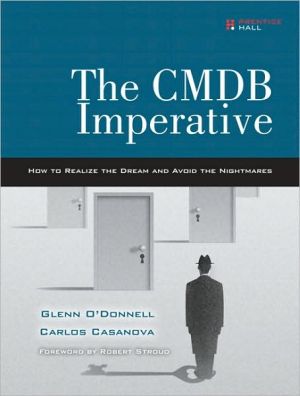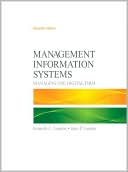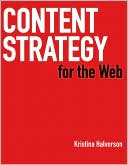The CMDB Imperative: How to Realize the Dream and Avoid the Nightmares
Implement Configuration Management Databases that Deliver Rapid ROI and Sustained Business Value\ Implementing an enterprise-wide Configuration Management Database (CMDB) is one of the most influential actions an IT organization can take to improve service delivery and bridge the gap between technology and the business. With a well-designed CMDB in place, companies are better positioned to manage and optimize IT infrastructure, applications, and services; automate more IT management tasks;...
Search in google:
Implement Configuration Management Databases that Deliver Rapid ROI and Sustained Business ValueImplementing an enterprise-wide Configuration Management Database (CMDB) is one of the most influential actions an IT organization can take to improve service delivery and bridge the gap between technology and the business. With a well-designed CMDB in place, companies are better positioned to manage and optimize IT infrastructure, applications, and services; automate more IT management tasks; and restrain burgeoning costs. Now, there’s an objective, vendor-independent guide to making a CMDB work in your organization. The CMDB Imperative presents a start-to-finish implementation methodology that works and describes how the CMDB is shifting to the superior Configuration Management System (CMS).Expert CMDB industry analyst Glenn O’Donnell and leading-edge architect and practitioner Carlos Casanova first review the drivers behind a CMDB and the technical, economic, cultural, and political obstacles to success. Drawing on the experiences of hundreds of organizations, they present indispensable guidance on architecting and customizing CMDB solutions to your specific environment. They’ll guide you through planning, implementation, transitioning into production, day-to-day operation and maintenance, and much more. Coverage includes Defining the tasks and activities associated with configuration management Understanding the CMDB’s role in ITIL and the relationship between CMDBs and ITIL v3’s CMS Building software models that accurately represent each entity in your IT environment Ensuring information accuracy via change management and automated discovery Understanding the state of the CMDB market and selling the CMDB within your organization Creating federated CMDB architectures that successfully balance autonomy with centralized control Planning a deployment strategy that sets appropriate priorities and reflects a realistic view of your organization’s maturity Integrating systems and leveraging established and emerging standards Previewing the future of the CMDB/CMS and how it will be impacted by key trends such as virtualization, SOA, mobility, convergence, and “flexi-sourcing”Foreword xiPrologue xiiiChapter 1: The Need for Process Discipline 1Chapter 2: What Is a CMDB? 25Chapter 3: Planning for the CMS 57Chapter 4: The Federated CMS Architecture 91Chapter 5: CMS Deployment Strategy 133Chapter 6: Integration—There’s No Way Around It! 177Chapter 7: The Future of the CMS 197Chapter 8: Continual Improvement for the CMS 241Chapter 9: Leveraging the CMS 265Chapter 10: Enjoy the Fruits of Success 297Glossary 313
Prologue Prologue\ This discussion comes from many years of experience in this field, watching companies start and stop their initiatives for a variety of reasons, most of which had some merit but almost all of which were simply postponing the inevitable. Some have survived punitive outsourcing by fighting against the tide of adoption. How much longer they can prevail depends upon their continued vigilance. We hope this book helps all companies succeed by giving them a guide to this vigilance.\ As authors of this book, we began to form our vision together, discussing the concepts of federation, leveraging of the DMTF CIM models and usage patterns in 2003 and 2004. We won’t reveal who first suggested it, but one day during one of our usual exchanges, we decided to write this book. We both heard the same questions and concerns about the CMDB and always found ourselves giving the same responses. It was clear that a comprehensive and authoritative guide was needed and that no books existed to offer the pragmatic view. The timing of ITIL v3 and the CMDB Federation Working Group appearing on the scene told us this was the right time to do it. In hindsight, we now think we were right even more than we did then. We hope you agree.\ We are excited that aspects of our vision are starting to become a reality but are also very disappointed that more companies didn’t move faster to address systemic foundational problems within their organizations. We have seen, and in some cases been directly impacted by, the failure of companies to address some of these systemic issues. Our mission is to help prevent such nightmares. The CMDB (more accurately, the CMS) holds great promise as one of the greatest forces toward the dream of disciplined IT service management. We trust The CMDB Imperative will help you to realize this dream and avoid the nightmares.\ © Copyright Pearson Education. All rights reserved.
Foreword xiPrologue xiiiAcknowledgments xvAbout the Authors xxiChapter 1 The Need for Process Discipline 1A Credibility Crisis for IT 2How IT Can Redeem Itself 3The Power of Process 5A Brief Review of Configuration in the ITIL Processes 6The Configuration Management Process 16Why the Term "CMDB" Must Go Away-and It Is...Slowly! 21Frequently Asked Questions 22Summary 24Chapter 2 What Is a CMDB? 25The Birth of the CMDB 26Configuration Items 27How Much Data Does a CI Need? 40A Brief Explanation of CMDB Federation 40CIs as the CMDB "DNA" 43Reconciliation 45The CMS Arrives 47Population the CMS 48CMS as an Integration Mechanism 50Frequently Asked Questions 52Summary 55Chapter 3 Planning for the CMS 57Do You Need a CMS and Why? 59Reality: What Is the State of the CMS Market? 61Acceptance: Selling the CMS to the Organization 68Structure: How Will the CMS Fit In? 74Quantity: How Many CMDBs Are Needed in the CMS? 76Accountability: Who "Owns" the CMS? 78Reuse: What Incumbent Tools Can Be Leveraged? 81Schedule: What Timelines Are Realistic? 84Frequently Asked Questions 88Summary 89Chapter 4 The Federated CMS Architecture 91Turning Data into Useful Information 91The Relationships Are Critical 92Where Is the Data? 94Link Data into Information Using Metadata 98The Distributed CMS in Practice 105Navigating the CMS Information Chains 125Why Federation Makes More Sense Than a Monolithic CMDB 125Integrating External Domains in the Federated Model 128Frequently Asked Questions 129Summary 131Chapter 5 CMS Deployment Strategy 133Getting YourHands Dirty 135What Comes First? 137Building Service and Application Infrastructure Models-It's What Matters 146Wait for the "Uber-CMDB/CMS" Technology... If You Can 152Attack the Domains 157Leverage Incumbent Tools 168Frequently Asked Questions 174Summary 175Chapter 6 Integration-There's No Way Around It! 177Standards: Past, Present, and Future 178Vendor Readiness 188CMS Object Modeling 189Software Engineering and Development Skills 191Frequently Asked Questions 194Summary 195Chapter 7 The Future of the CMS 197Dynamic Technologies and Services Fuel the CMS Imperative 197The Extra Dimension of Time 216ITIL v3 and the CMDB Shift 224The Service Catalog and the CMS 228Object Modeling Technologies Need to Mature 233CMS: The Lifeblood of Every IT and Business Service Function 234Frequently Asked Questions 238Summary 239Chapter 8 Continual Improvement for the CMS 241Metrics for the CMS 241The Cyclic Nature of Improvement 244Begin with Small Steps and Build Out 248Statistical Quality Control 253Maintain Data and Information Accuracy 256Evolve Based on Customer Requirements 259Frequently Asked Questions 262Summary 263Chapter 9 Leveraging the CMS 265Inbound CMS Data 266Outbound CMS Data 280The Complete Circle 294Frequently Asked Questions 295Summary 296Chapter 10 Enjoy the Fruits of Success 297Measuring Success 297Evangelizing Your Success 304Frequently Asked Questions 311Summary 312Glossary 313Index 325








